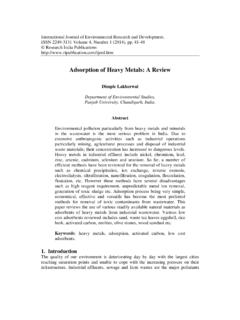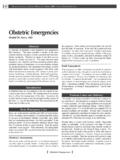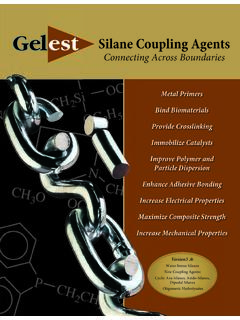Transcription of A Practical Approach to Hypercalcemia
1 MAY1, 2003 / VOLUME67, inorganic molecules. Low albumin lev-els can affect the total serum calcium measuring the free calcium level ismore convenient and accurate, but the follow-ing formula can be used to calculate the cor-rected total serum calcium level:Corrected calcium = ( g per dL [plasma albumin]) + [serum calcium]Parathyroid hormone (PTH), 1,25-dihy-droxyvitamin D3(calcitriol), and calcitonincontrol calcium homeostasis in the body(Table 1).Increased bone resorption, increasedgastrointestinal absorption of calcium, anddecreased renal excretion of calcium causehypercalcemia. Normal serum calcium levelsare 8 to 10 mg per dL ( to mmol per L,Figure 1),although the exact range can varyamong laboratories. Normal ionized calciumlevels are 4 to mg per dL (1 to mmol perL).
2 Hypercalcemia is considered mild if thetotal serum calcium level is between and12 mg per dL ( and 3 mmol per L).5 Levelshigher than 14 mg per dL ( mmol per L)can be life is an 84-amino acid hormone pro-duced by the four pea-sized parathyroid glandsposterior to the thyroid gland. In response tolow serum calcium levels, PTH raises calciumHypercalcemia is a disordercommonly encountered byprimary care one in 500patients who are treated in ageneral medicine clinic have undiagnosed pri-mary hyperparathyroidism, the leading causeof diagnosis of hyper-calcemia most often is made incidentallywhen a high calcium level is detected in bloodsamples. The principal challenges in the man-agement of Hypercalcemia are distinguishingprimary hyperparathyroidism from condi-tions that will not respond to parathyroidec-tomy and knowing when it is appropriate torefer the patient for surgery.
3 It is essential thatphysicians know how to evaluate and opti-mally manage patients with Hypercalcemia ,because treatment and prognosis vary accord-ing to the underlying of HypercalcemiaThe skeleton contains 98 percent of totalbody calcium; the remaining 2 percent circu-lates throughout the body. One half of circu-lating calcium is free (ionized) calcium, theonly form that has physiologic effects. Theremainder is bound to albumin, globulin, andHypercalcemia is a disorder commonly encountered by primary care physicians. The diag-nosis often is made incidentally in asymptomatic patients. Clinical manifestations affect theneuromuscular, gastrointestinal, renal, skeletal, and cardiovascular systems. The most com-mon causes of Hypercalcemia are primary hyperparathyroidism and malignancy. Someother important causes of Hypercalcemia are medications and familial hypocalciuric hyper-calcemia.
4 An initial diagnostic work-up should include measurement of intact parathyroidhormone, and any medications that are likely to be causative should be hormone is suppressed in malignancy-associated Hypercalcemia and elevatedin primary hyperparathyroidism. It is essential to exclude other causes before consideringparathyroid surgery, and patients should be referred for parathyroidectomy only if theymeet certain criteria. Many patients with primary hyperparathyroidism have a benigncourse and do not need surgery. Hypercalcemic crisis is a life-threatening intravenous rehydration is the mainstay of management in severe hypercal-cemia, and antiresorptive agents, such as calcitonin and bisphosphonates, frequently canalleviate the clinical manifestations of hypercalcemic disorders.
5 (Am Fam Physician2003;67:1959-66. Copyright 2003 American Academy of Family Physicians)A Practical Approach to HypercalcemiaMARY F. CARROLL, , Eastern New Mexico Medical Center, Roswell, New MexicoDAVID S. SCHADE, , University of New Mexico School of Medicine and Health Sciences Center,Albuquerque, New MexicoSee page 1853 fordefinitions of strength-of-evidence by accelerating osteoclastic bone resorp-tion and increasing renal tubular resorption ofcalcium. It also increases calcitriol, which indi-rectly raises serum calcium levels. PTH causesphosphate loss through the kidneys. Thus, inpatients with PTH-mediated Hypercalcemia ,serum phosphate levels tend to be D is a steroid hormone that isobtained through the diet or produced by theaction of sunlight on vitamin D precursors inthe skin. Calcitriol, the active form of vitaminD,is derived from successive hydroxylation ofthe precursor cholecalciferol, first in the liver(25-hydroxylation), then in the kidneys (1-hydroxylation).
6 Adequate vitamin D is nec-essary for bone formation. However, the prin-cipal target for vitamin D is the gut, where itincreases the absorption of calcium and phos-phate. Thus, in vitamin D-mediated hypercal-cemia, serum phosphate levels tend to be is a 32-amino acid hormone pro-duced by the parafollicular C cells of the thy-roid. Calcitonin is a weak inhibitor of osteoclastactivation and opposes the effects of PTH onthe kidneys, thereby promoting calcium andphosphate excretion. Calcitonin levels might beelevated in pregnant patients and in patientswith medullary carcinoma of the ,there are no direct clinical sequelae,and serum calcium levels usually are peptide (PTHrP) is the princi-pal mediator in Hypercalcemia associated withsolid is homologous with PTHat the amino terminus, the region that com-prises the receptor-binding domain.
7 PTHrPbinds the PTH receptor and mimics the bio-logic effects of PTH on bones and the Manifestations of HypercalcemiaThe optimal concentration of serum ionizedcalcium is essential for normal cellular func-tion. Hypercalcemia leads to hyperpolariza-tion of cell membranes. Patients with levels ofcalcium between and 12 mg per dL can the serum calcium levelrises above this stage, multisystem manifesta-tions become apparent (Table 2).This constel-lation of symptoms has led to the mnemonic Stones, bones, abdominal moans, and , NUMBER9 / MAY1, 2003 TABLE 1 Actions of the Hormones Involved in Calcium HomeostasisHormoneEffect on bonesEffect on gutEffect on kidneysParathyroid hormone Ca++, Supports osteoclast Indirect effects via Supports Ca++resorption PO4levels in bloodresorption calcitriol from and PO4excretion, activates 1-hydroxylation1-hydroxylationCalcitriol (vitamin D) Ca++, No direct effects Ca++and PO4No direct effects PO4levels in bloodSupports osteoblastsabsorptionCalcitonin causes Ca++, PO4 Inhibits osteoclast No direct effectsPromotes Ca++and PO4levels in blood when resorptionexcretionhypercalcemia is presentCa++= calcium; PO4= phosphate 1.
8 Spectrum of Hypercalcemia indicated by serum total and ionized calcium of HypercalcemiaIonized serum calcium level, mg/dL (mmol/L)4 (1) ( )8 (2)10 ( )12 (3)NormocalcemiaMild hypercalcemiaModeratehypercalcemiaHyperc alcemiccrisisTotal serum calcium level, mg/dL (mmol/L)8 (2)10 ( )12 (3)14 ( )16 (4)groans, which is used to recall the signs andsymptoms of Hypercalcemia , particularly as aresult of primary effects include impairedconcentration, confusion, corneal calcifica-tion, fatigue, and muscle ,abdominal pain, anorexia, constipation, and,rarely, peptic ulcer disease or pancreatitis areamong the gastrointestinal most important renal effects are polydip-sia and polyuria resulting from nephrogenicdiabetes insipidus, and nephrolithiasis result-ing from hypercalciuria. Other renal effectsinclude dehydration and effects include hypertension,vascular calcification, and a shortened QTinterval on the electrocardiogram.
9 Cardiacarrhythmias are rare. Bone pain can occur inpatients with hyperparathyroidism or malig-nancy. Osteoporosis of cortical bone, such asthe wrist, is mainly associated with PTH also canresult in subperiosteal resorption, leading toosteitis fibrosa cystica with bone cysts andbrown tumors of the long Diagnosis for HypercalcemiaPrimary hyperparathyroidism and malig-nancy account for more than 90 percent ofhypercalcemia cases. These conditions must bedifferentiated early to provide the patient withoptimal treatment and accurate Hypercalcemia of malignancy impliesa very limited life expectancy often only a mat-ter of weeks. On the other hand, primary hyper-parathyroidism has a relatively benign causes of Hypercalcemia can be dividedinto seven categories: hyperparathyroidism,vitamin D-related causes, malignancy, med-ications, other endocrine disorders, geneticdisorders, and miscellaneous causes (Table 3).
10 Evaluation of a patient with Hypercalcemia (Figure 2) should include a careful history andphysical examination focusing on clinicalmanifestations of Hypercalcemia , risk factorsfor malignancy, causative medications, and afamily history of Hypercalcemia -associatedconditions ( , kidney stones).MAY1, 2003 / VOLUME67, 2 Clinical Manifestations of HypercalcemiaRenal stones NephrolithiasisNephrogenic diabetes insipidusDehydrationNephrocalcinosisSkel eton bones Bone painArthritisOsteoporosisOsteitis fibrosa cystica in hyperparathyroidism (subperiostealresorption, bone cysts)Gastrointestinal abdominalmoans Nausea, vomitingAnorexia, weight lossConstipationAbdominal painPancreatitisPeptic ulcer diseaseNeuromuscular psychic groans Impaired concentration and memoryConfusion, stupor, comaLethargy and fatigueMuscle weaknessCorneal calcification (band keratopathy)













